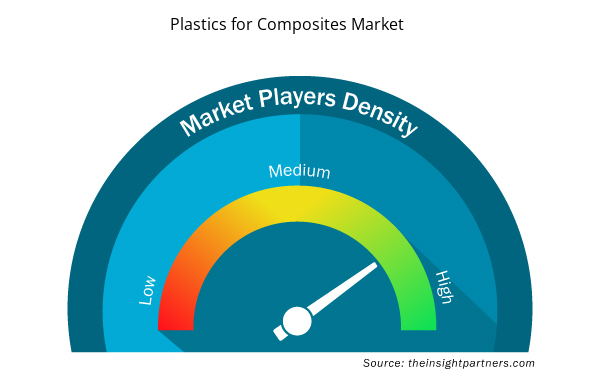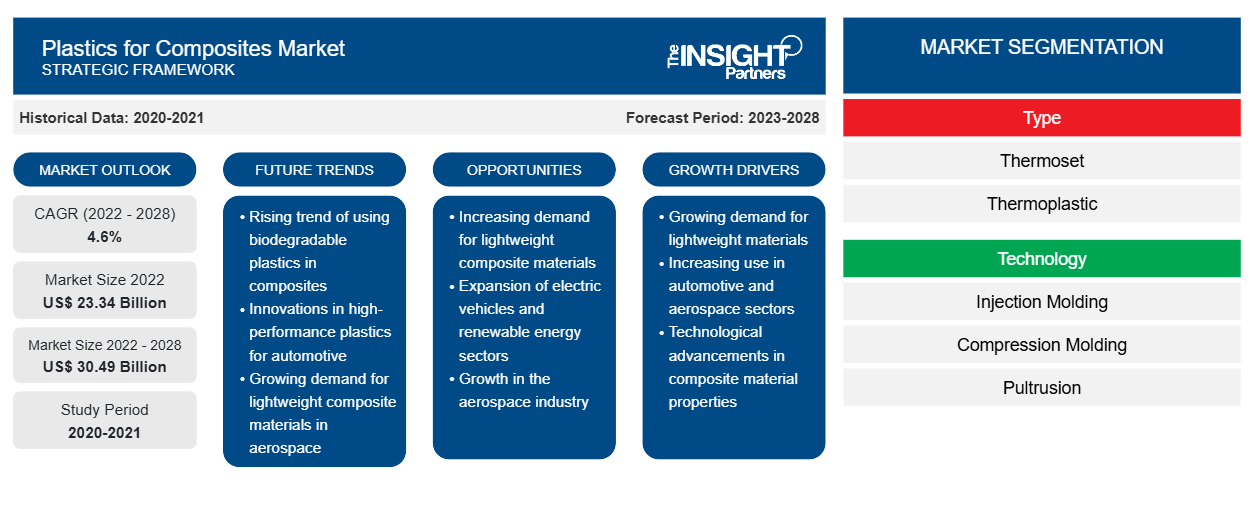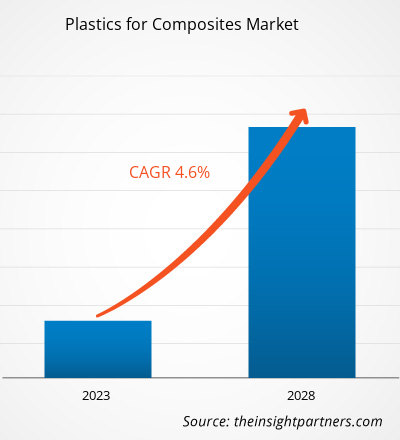Der Markt für Kunststoffe für Verbundwerkstoffe soll von 23.337,24 Millionen US-Dollar im Jahr 2022 auf 30.490,85 Millionen US-Dollar im Jahr 2028 wachsen; von 2022 bis 2028 wird eine durchschnittliche jährliche Wachstumsrate (CAGR) von 4,6 % erwartet.CAGR of 4.6% from 2022 to 2028.
Verbundwerkstoffe sind Materialien, die aus zwei oder mehr chemisch und physikalisch unterschiedlichen Phasen bestehen, die durch eine unterschiedliche Schnittstelle getrennt sind. Die meisten kommerziell hergestellten Verbundwerkstoffe verwenden ein Polymermatrixmaterial, das oft als Harzlösung bezeichnet wird. Häufig verwendete Polymermatrizen sind Polyester, Vinylester, Epoxid, Phenol, Polyimid, Polyamid, Polypropylen und Polyetheretherketon (PEEK). Niedrige Kosten, einfache Verarbeitbarkeit, gute chemische Beständigkeit und geringes spezifisches Gewicht sind einige der Hauptvorteile von Polymermatrizen.phenolic, polyimide, polyamide, polypropylene, and polyether ether ketone (PEEK). Low cost, easy processability, good chemical resistance, and low specific gravity are among the major advantages associated with polymer matrices.
Die zunehmende Verwendung von Verbundharzen in Bau- und Konstruktionsaktivitäten sowie in der Luft- und Raumfahrt und im Militärbereich trägt zum Wachstum des Marktes für Kunststoffe für Verbundwerkstoffe bei . Darüber hinaus ist die Nachfrage nach Leichtbaumaterialien im Fahrzeugbau zur Verbesserung der Kraftstoffeffizienz ein weiterer Faktor, der die Expansion des Marktes vorantreibt. Darüber hinaus trägt die steigende Nachfrage nach thermoplastischen Harzen erheblich zum Gesamtwachstum des Marktes für Kunststoffe für Verbundwerkstoffe bei. Steife Fasern und höhere Hitzebeständigkeit, Rissfestigkeit, hohe Schlagfestigkeit und eine robuste Polymermatrix sind die Hauptmerkmale von Polymerverbundwerkstoffen, die ihre Popularität vorantreiben. Steigende Investitionen in die Erzeugung erneuerbarer Energien werden in den kommenden Jahren wahrscheinlich die Nachfrage nach Polymerverbundwerkstoffen ankurbeln.
Passen Sie diesen Bericht Ihren Anforderungen an
Sie erhalten kostenlos individuelle Anpassungen an jedem Bericht, einschließlich Teilen dieses Berichts oder einer Analyse auf Länderebene, eines Excel-Datenpakets sowie tolle Angebote und Rabatte für Start-ups und Universitäten.
- Holen Sie sich die wichtigsten Markttrends aus diesem Bericht.Dieses KOSTENLOSE Beispiel umfasst eine Datenanalyse von Markttrends bis hin zu Schätzungen und Prognosen.
Markteinblicke
Steigende Nachfrage aus der Automobil- und Luftfahrtindustrie treibt das Wachstum des Marktes für Kunststoffe für Verbundwerkstoffe voran
Das Verbundharz wird in verschiedenen Anwendungen eingesetzt, darunter Bauwesen und Infrastruktur, Transport, Elektrik und Elektronik, Windenergie, Pipelines und Tanks, Schifffahrt sowie Luft- und Raumfahrt und Militär. Moderne Materialien sind entscheidend, um den Kraftstoffverbrauch moderner Autos zu senken und gleichzeitig Sicherheit und Leistung zu gewährleisten. Da zum Beschleunigen leichterer Objekte weniger Energie benötigt wird als zum Beschleunigen schwererer Objekte, bieten leichte Materialien ein hervorragendes Potenzial zur Steigerung der Fahrzeugeffizienz. Daher treibt die hohe Nachfrage der Automobilindustrie nach Verbundwerkstoffen zur Herstellung kraftstoffsparender, leichter Fahrzeuge das Wachstum des Marktes für Kunststoffe für Verbundwerkstoffe an. Endverbrauchsindustrien in Schwellenländern wie China und Indien tragen am meisten zur steigenden Nachfrage nach Kunststoffen für Verbundwerkstoffe bei. Der zunehmende Bedarf an leichteren Materialien zur Herstellung von Flugzeugkomponenten und -teilen ist ein weiterer wichtiger Faktor, der zum Wachstum des Marktes für Kunststoffe für Verbundwerkstoffe beiträgt. Flugzeughersteller bemühen sich, die primären thermoplastischen Strukturen in Geschäfts- und Verkehrsflugzeugen zu vergrößern. Sie waren die ersten Anwender langfaserverstärkter Thermoplaste.
Typ-Einblicke
Der Markt für Kunststoffe für Verbundwerkstoffe ist nach Typ in Duroplaste (Polyester, Vinylester, Epoxid, Polyurethan und andere) und Thermoplaste (Polypropylen, Polyethylen, Polyvinylchlorid, Polystyrol, Polyethylenterephthalat, Polycarbonat und andere) unterteilt. Das Duroplast-Segment hatte 2021 einen größeren Marktanteil. Duroplaste sind ein beliebtes Polymermatrixmaterial für faserverstärkten Verbundwerkstoffe. Gängige Beispiele für Duroplaste sind Epoxide und Polyester. Sie gehören zu den wichtigsten Arten von Matrixsystemen, die speziell in der Luft- und Raumfahrtindustrie verwendet werden. Duroplast-Matrixverbundwerkstoffe werden aufgrund ihrer geringeren Viskosität bei relativ niedrigen Temperaturen (weniger als 100 °C), die den Harz-/Faserbenetzungsprozess besser erleichtert, häufiger verwendet als thermoplastische Matrixverbundwerkstoffe. Diese Faktoren werden voraussichtlich das Wachstum des Marktes für Duroplast-Matrixkomponenten vorantreiben .
Lanxess AG, Covestro AG, Celanese Corp, INEOS Group Holdings SA, Daicel Corp, BASF SE, Evonik Industries AG, Solvay SA, Saudi Basic Industries Corp und Arkema SA gehören zu den wichtigsten Akteuren auf dem Markt für Kunststoffe für Verbundwerkstoffe. Die führenden Akteure verfolgen Strategien wie Fusionen und Übernahmen sowie Produkteinführungen, um ihre geografische Präsenz und Kundenbasis zu erweitern. So brachte Lanxess AG im Juni 2022 einen Verbundwerkstoff mit Polyamid-6-Matrix auf Basis von „grünem“ Cyclohexan auf den Markt.
Regionale Einblicke in den Markt für Kunststoffe für Verbundwerkstoffe
Die regionalen Trends und Faktoren, die den Markt für Kunststoffe für Verbundwerkstoffe im Prognosezeitraum beeinflussen, wurden von den Analysten von Insight Partners ausführlich erläutert. In diesem Abschnitt werden auch die Marktsegmente und die Geografie von Kunststoffen für Verbundwerkstoffe in Nordamerika, Europa, im asiatisch-pazifischen Raum, im Nahen Osten und Afrika sowie in Süd- und Mittelamerika erörtert.

- Erhalten Sie regionale Daten zum Markt für Kunststoffe für Verbundwerkstoffe
Umfang des Marktberichts „Kunststoffe für Verbundwerkstoffe“
| Berichtsattribut | Details |
|---|---|
| Marktgröße im Jahr 2022 | 23,34 Milliarden US-Dollar |
| Marktgröße bis 2028 | 30,49 Milliarden US-Dollar |
| Globale CAGR (2022 - 2028) | 4,6 % |
| Historische Daten | 2020-2021 |
| Prognosezeitraum | 2023–2028 |
| Abgedeckte Segmente | Nach Typ
|
| Abgedeckte Regionen und Länder | Nordamerika
|
| Marktführer und wichtige Unternehmensprofile |
|
Dichte der Marktteilnehmer für Kunststoffe für Verbundwerkstoffe: Auswirkungen auf die Geschäftsdynamik verstehen
Der Markt für Kunststoffe für Verbundwerkstoffe wächst rasant. Die Nachfrage der Endverbraucher steigt aufgrund von Faktoren wie sich entwickelnden Verbraucherpräferenzen, technologischen Fortschritten und einem größeren Bewusstsein für die Vorteile des Produkts. Mit der steigenden Nachfrage erweitern Unternehmen ihr Angebot, entwickeln Innovationen, um die Bedürfnisse der Verbraucher zu erfüllen, und nutzen neue Trends, was das Marktwachstum weiter ankurbelt.
Die Marktteilnehmerdichte bezieht sich auf die Verteilung von Firmen oder Unternehmen, die in einem bestimmten Markt oder einer bestimmten Branche tätig sind. Sie gibt an, wie viele Wettbewerber (Marktteilnehmer) in einem bestimmten Marktraum im Verhältnis zu seiner Größe oder seinem gesamten Marktwert präsent sind.
Die wichtigsten auf dem Markt für Kunststoffe für Verbundwerkstoffe tätigen Unternehmen sind:
- Lanxess AG
- Covestro AG
- Celanese Corp
- INEOS Group Holdings SA
- Daicel Corp
Haftungsausschluss : Die oben aufgeführten Unternehmen sind nicht in einer bestimmten Reihenfolge aufgeführt.

- Überblick über die wichtigsten Akteure auf dem Markt für Kunststoffe für Verbundwerkstoffe
Bericht-Spotlights
- Fortschrittliche Trends in der Kunststoff- und Verbundwerkstoffindustrie helfen den Akteuren bei der Entwicklung wirksamer langfristiger Strategien
- Von Unternehmen verfolgte Geschäftswachstumsstrategien zur Sicherung des Wachstums in entwickelten und sich entwickelnden Märkten
- Quantitative Analyse des globalen Marktes für Kunststoffe für Verbundwerkstoffe von 2020 bis 2028
- Abschätzung des Bedarfs an Kunststoffen für Verbundwerkstoffe in verschiedenen Branchen
- Porters Fünf-Kräfte-Analyse zur Veranschaulichung der Wirksamkeit von Käufern und Lieferanten in der Kunststoff-Verbundwerkstoffindustrie
- Aktuelle Entwicklungen zum Verständnis des Wettbewerbsmarktszenarios und der Nachfrage nach Kunststoffen für Verbundwerkstoffe
- Markttrends und -aussichten sowie Faktoren, die das Wachstum des Marktes für Kunststoffe für Verbundwerkstoffe bestimmen
- Aufschlussreiche Strategien, die das kommerzielle Interesse am Marktwachstum untermauern und den Entscheidungsprozess unterstützen
- Kunststoffe für Verbundwerkstoffe Marktgröße an verschiedenen Knotenpunkten des Marktes
- Detaillierte Übersicht und Segmentierung des Marktes sowie seiner Branchendynamik
- Marktgröße für Kunststoffe für Verbundwerkstoffe in verschiedenen Regionen mit vielversprechenden Wachstumschancen
Die „Marktanalyse für Kunststoffe für Verbundwerkstoffe bis 2028“ ist eine spezialisierte und eingehende Studie der Chemie- und Materialindustrie, die sich auf die Trendanalyse des Marktes für Kunststoffe für Verbundwerkstoffe konzentriert. Der Bericht soll einen Überblick über den Markt mit detaillierter Segmentierung geben. Der Markt für Kunststoffe für Verbundwerkstoffe ist nach Typ, Technologie und Geografie segmentiert. Basierend auf dem Typ ist der Markt in Duroplaste (Polyester, Vinylester, Epoxid, Polyurethan und andere) und Thermoplaste (Polypropylen, Polyethylen, Polyvinylchlorid, Polystyrol, Polyethylenterephthalat, Polycarbonat und andere) unterteilt. Basierend auf der Technologie ist der Markt in Spritzguss, Kompressionsguss, Pultrusion, Harzinfusion und andere segmentiert. In Bezug auf die Geografie ist der Markt in fünf Hauptregionen segmentiert – Nordamerika, Europa, Asien-Pazifik, Naher Osten und Afrika sowie Süd- und Mittelamerika. Im Jahr 2021 dominierte der Asien-Pazifik-Raum den Markt für Kunststoffe für Verbundwerkstoffe. Die Region wird im Prognosezeitraum voraussichtlich die höchste CAGR des Marktes verzeichnen. Die Automobil- und Bauindustrie im asiatisch-pazifischen Raum wächst rasant. Es ist die bevölkerungsreichste Region der Welt und die Region beherbergt eine der am schnellsten wachsenden Bauindustrien der Welt. Diese Faktoren tragen zu einer hohen Nachfrage nach Kunststoffen für Verbundwerkstoffe im asiatisch-pazifischen Raum bei.
- Historische Analyse (2 Jahre), Basisjahr, Prognose (7 Jahre) mit CAGR
- PEST- und SWOT-Analyse
- Marktgröße Wert/Volumen – Global, Regional, Land
- Branche und Wettbewerbsumfeld
- Excel-Datensatz



Report Coverage
Revenue forecast, Company Analysis, Industry landscape, Growth factors, and Trends

Segment Covered
This text is related
to segments covered.

Regional Scope
North America, Europe, Asia Pacific, Middle East & Africa, South & Central America

Country Scope
This text is related
to country scope.
Häufig gestellte Fragen
The increasing utilization of plastics for composites in building & construction activity, aerospace, and military applications are some of the key factors that contribute to the growth of the market. In addition, the demand for lightweight materials from transportation, which in response improves the efficiency of fuel, is another factor propelling the expansion of the market. These factors are driving the plastics for composites market growth.
During the forecast period, thermoplastic is expected to be the fastest-growing segment. The growing adoption of thermoplastic within the automotive industry, rising demand for recyclable and fast-curing materials, increasing demand for automobiles, and growing penetration of composite materials by replacing metals are significant factors boosting the growth of the thermoplastic segment in plastics for composites market demand during the forecast period.
During the forecast period, the compression molding segment is expected to be the fastest-growing segment. The manufacture of various parts of electronic and automotive products has increased due to the increased demand for automotive and electrical products, particularly vehicles, mobile phones and tablets. The compression molding process is primarily used in the fabrication of these parts. These factors are expected to accelerate the growth of the compression molding segment of the plastics for composites market.
In 2021, the thermoset segment held the largest market share. Increased use of thermoset plastic in the aerospace and automobile industry due to their lower viscosity at relatively low temperatures (less than 100°C), which better facilitates the resin/fiber wetting process led to the dominance of the thermoset segment in the plastics for composites market.
The major players operating in the plastics for composites market are Lanxess AG, Covestro AG, Celanese Corp, INEOS Group Holdings SA, Daicel Corp, BASF SE, Evonik Industries AG, Solvay SA, Saudi Basic Industries Corp, and Arkema SA.
In 2021, Asia-Pacific accounted for the largest share of the global plastics for composites market. Growing demand from construction, wind power, electronics, and automotive industries led to the dominance of the Asia Pacific region in 2021.
Trends and growth analysis reports related to Chemicals and Materials : READ MORE..
The List of Companies - Plastics for Composites Market
- Lanxess AG
- Covestro AG
- Celanese Corp
- INEOS Group Holdings SA
- Daicel Corp
- BASF SE
- Evonik Industries AG
- Solvay SA
- Saudi Basic Industries Corp
- Arkema SA
The Insight Partners performs research in 4 major stages: Data Collection & Secondary Research, Primary Research, Data Analysis and Data Triangulation & Final Review.
- Data Collection and Secondary Research:
As a market research and consulting firm operating from a decade, we have published and advised several client across the globe. First step for any study will start with an assessment of currently available data and insights from existing reports. Further, historical and current market information is collected from Investor Presentations, Annual Reports, SEC Filings, etc., and other information related to company’s performance and market positioning are gathered from Paid Databases (Factiva, Hoovers, and Reuters) and various other publications available in public domain.
Several associations trade associates, technical forums, institutes, societies and organization are accessed to gain technical as well as market related insights through their publications such as research papers, blogs and press releases related to the studies are referred to get cues about the market. Further, white papers, journals, magazines, and other news articles published in last 3 years are scrutinized and analyzed to understand the current market trends.
- Primary Research:
The primarily interview analysis comprise of data obtained from industry participants interview and answers to survey questions gathered by in-house primary team.
For primary research, interviews are conducted with industry experts/CEOs/Marketing Managers/VPs/Subject Matter Experts from both demand and supply side to get a 360-degree view of the market. The primary team conducts several interviews based on the complexity of the markets to understand the various market trends and dynamics which makes research more credible and precise.
A typical research interview fulfils the following functions:
- Provides first-hand information on the market size, market trends, growth trends, competitive landscape, and outlook
- Validates and strengthens in-house secondary research findings
- Develops the analysis team’s expertise and market understanding
Primary research involves email interactions and telephone interviews for each market, category, segment, and sub-segment across geographies. The participants who typically take part in such a process include, but are not limited to:
- Industry participants: VPs, business development managers, market intelligence managers and national sales managers
- Outside experts: Valuation experts, research analysts and key opinion leaders specializing in the electronics and semiconductor industry.
Below is the breakup of our primary respondents by company, designation, and region:

Once we receive the confirmation from primary research sources or primary respondents, we finalize the base year market estimation and forecast the data as per the macroeconomic and microeconomic factors assessed during data collection.
- Data Analysis:
Once data is validated through both secondary as well as primary respondents, we finalize the market estimations by hypothesis formulation and factor analysis at regional and country level.
- Macro-Economic Factor Analysis:
We analyse macroeconomic indicators such the gross domestic product (GDP), increase in the demand for goods and services across industries, technological advancement, regional economic growth, governmental policies, the influence of COVID-19, PEST analysis, and other aspects. This analysis aids in setting benchmarks for various nations/regions and approximating market splits. Additionally, the general trend of the aforementioned components aid in determining the market's development possibilities.
- Country Level Data:
Various factors that are especially aligned to the country are taken into account to determine the market size for a certain area and country, including the presence of vendors, such as headquarters and offices, the country's GDP, demand patterns, and industry growth. To comprehend the market dynamics for the nation, a number of growth variables, inhibitors, application areas, and current market trends are researched. The aforementioned elements aid in determining the country's overall market's growth potential.
- Company Profile:
The “Table of Contents” is formulated by listing and analyzing more than 25 - 30 companies operating in the market ecosystem across geographies. However, we profile only 10 companies as a standard practice in our syndicate reports. These 10 companies comprise leading, emerging, and regional players. Nonetheless, our analysis is not restricted to the 10 listed companies, we also analyze other companies present in the market to develop a holistic view and understand the prevailing trends. The “Company Profiles” section in the report covers key facts, business description, products & services, financial information, SWOT analysis, and key developments. The financial information presented is extracted from the annual reports and official documents of the publicly listed companies. Upon collecting the information for the sections of respective companies, we verify them via various primary sources and then compile the data in respective company profiles. The company level information helps us in deriving the base number as well as in forecasting the market size.
- Developing Base Number:
Aggregation of sales statistics (2020-2022) and macro-economic factor, and other secondary and primary research insights are utilized to arrive at base number and related market shares for 2022. The data gaps are identified in this step and relevant market data is analyzed, collected from paid primary interviews or databases. On finalizing the base year market size, forecasts are developed on the basis of macro-economic, industry and market growth factors and company level analysis.
- Data Triangulation and Final Review:
The market findings and base year market size calculations are validated from supply as well as demand side. Demand side validations are based on macro-economic factor analysis and benchmarks for respective regions and countries. In case of supply side validations, revenues of major companies are estimated (in case not available) based on industry benchmark, approximate number of employees, product portfolio, and primary interviews revenues are gathered. Further revenue from target product/service segment is assessed to avoid overshooting of market statistics. In case of heavy deviations between supply and demand side values, all thes steps are repeated to achieve synchronization.
We follow an iterative model, wherein we share our research findings with Subject Matter Experts (SME’s) and Key Opinion Leaders (KOLs) until consensus view of the market is not formulated – this model negates any drastic deviation in the opinions of experts. Only validated and universally acceptable research findings are quoted in our reports.
We have important check points that we use to validate our research findings – which we call – data triangulation, where we validate the information, we generate from secondary sources with primary interviews and then we re-validate with our internal data bases and Subject matter experts. This comprehensive model enables us to deliver high quality, reliable data in shortest possible time.


 Holen Sie sich ein kostenloses Muster für diesen Bericht
Holen Sie sich ein kostenloses Muster für diesen Bericht